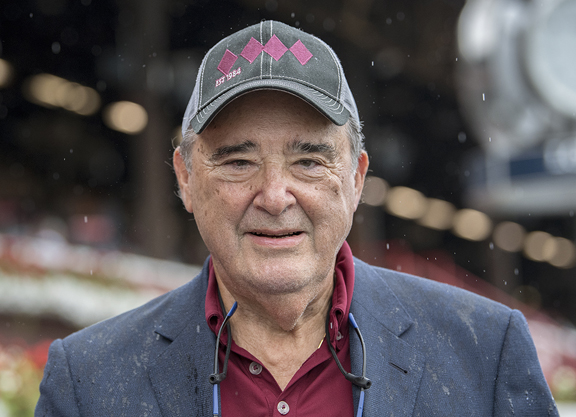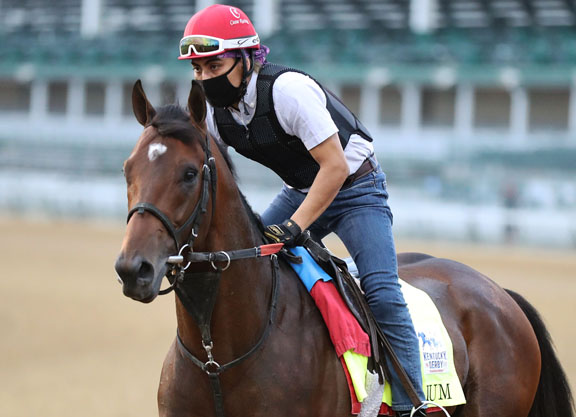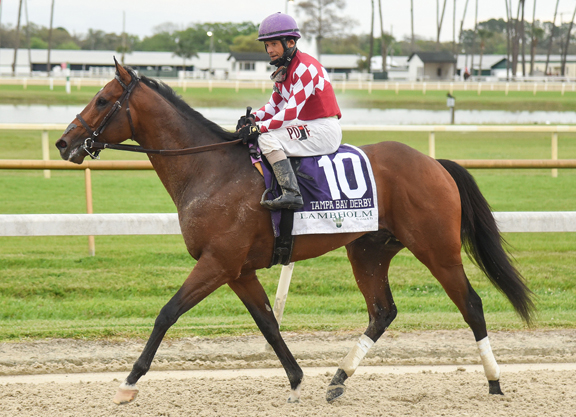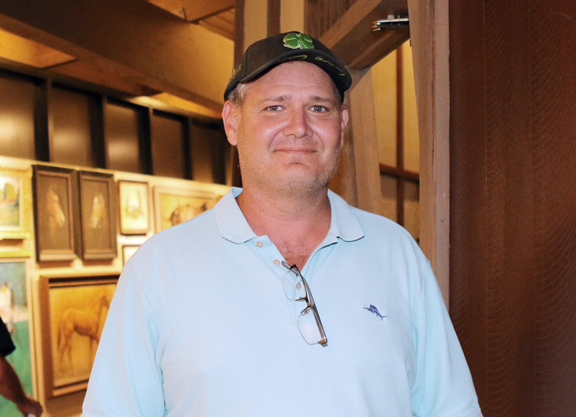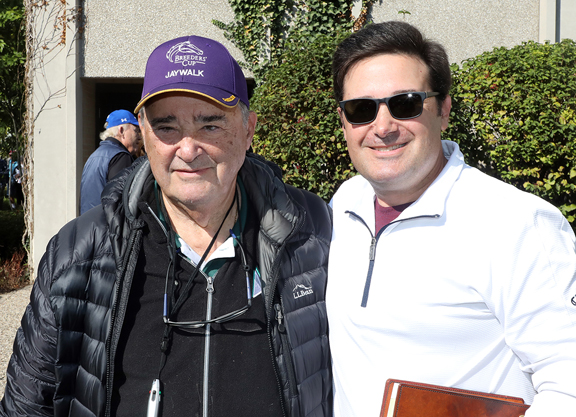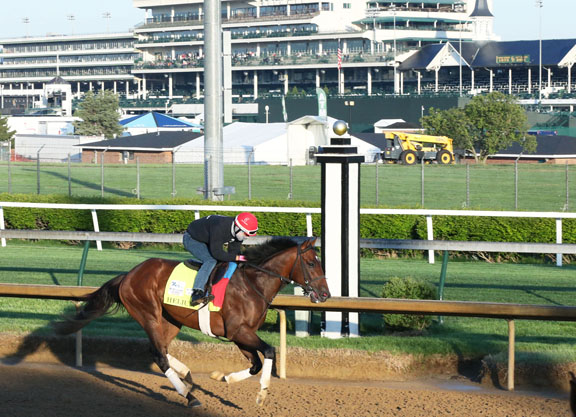By Chris McGrath
One after another, the lights were turning red on the young Leonard Green. He had a bad stutter that made him an introvert in mixed company. Dyslexic, too. Couldn't keep numbers in his head: hardly, as such, an accountant in the making. Sure enough, he'd now been fired from a fourth job in a row.
“I didn't even know what an entrepreneur was,” Green recalls now. “But it turned out to be somebody who thought outside the box, and took calculated risks, and spotted opportunities. And–boom! I suddenly realized that was what I wanted to do.”
Over half a century later, still in New Jersey, that discovery has not just sustained him in a brilliant business career, but has brought him toward a fresh pinnacle in what has already been an equally fulfilling life on the Turf. No coincidence, either, that the unbeaten colt who represents his D.J. Stable in the GI Kentucky Derby (presented by Woodford Reserve) on Saturday has followed so unconventional a path in the defining quest of the American Thoroughbred. Helium (Ironicus) arrives after a single start on dirt, which was also his only journey round a second turn; and rather than gain more experience of these novelties, he has been deliberately kept out of the fray through eight weeks since his breakout success in the GII Tampa Bay Derby. The horse is trying to flout all precedent. But jumping through the hoops of orthodoxy has never been Green's style.
In fact, figuring out his own way of doing things was just what enabled him to turn round the disadvantages of his youth. They say that necessity is the mother of invention, and the fact that he couldn't just glide unthinkingly through social intercourse actually made it second nature for Green to deconstruct presumptions; to ask himself if there mightn't be another way round any given impediment.
“If you know how to speak without any problems, you just speak,” Green says. “With me, because I'd suddenly get caught up, I had to think of how I could say things in a different way.”
At OBS last week he exchanged these experiences with another high achiever in our business who had overcome very similar challenges.
“It was fascinating,” Green says. “We talked about how we think about things beforehand, about how we try to prepare ourselves, and then how to pivot when we get in a situation. And suddenly I realized that because of that, I really know how to pivot when I get into a business situation. I know how to get prepared, and how to take a calculated risk. So, I think it's been a blessing, I really do, because it's made me think differently from other people.”
He stresses that redemption had other dimensions, too. Nobody was going to outwork him, for one thing; and then there was the belief of “a brilliant young lady” named Lois he was fortunate enough to meet in college and marry over 60 years ago. But it's certainly true that figuring out his own, maverick strategy sometimes increased the yield without necessarily increasing the odds against success.
When you have been involved in over 40 companies, you can't hit the bull's-eye every time. But it's not hard to see why a man like this should relish trainer Mark Casse ignoring all the edicts on a Derby preparation. One of Green's axioms is: “If it ain't broke, break it.” In other words, don't be complacent in standard practice. Because there could be an even better way out there.
At the auction in Ocala, Green was amused to note how stubbornly the market sticks to what it knows.
“The announcer would watch a horse enter the ring and say, 'Here's an opportunity for you to have a Kentucky Derby winner,'” he says, laughing. “Because this horse was by Into Mischief or Tapit or Curlin or Quality Road or a hot, proven stallion. The auctioneer never said, 'Because this is a horse by Ironicus!' And as soon as they came in with a :9 4/5 or a :10 flat breeze you knew it was going to be $200,000 straightaway. And people new in the business would be jumping in, because they're being told, 'Boy, this horse is fast.' But you know, I can't find any two-furlong races…”
The maverick play has always been rewarding for Green, whether in sensing that SoBe Beverages could sidestep the titan brands of Pepsi and Coke, or in becoming one of the founding investors in Blue Buffalo Pet Foods. “Which was one of the first all-natural dog and cat foods, when everything else was filled with junk that could cause cancer,” he says. “Not that I didn't have some clunkers along the line.”
But he says that those have to be embraced, as well, because they often contain valuable lessons. Here, then, is a man who thrives on constant, dynamic engagement. That's why he loves teaching, and why his Babson College course is not about commercial formulae, but about stuff that happens in the real world; hence, also, the success of his lauded manual, “The Entrepreneur's Playbook”.
Unsurprising, then, that the octogenarian was not only working all last Sunday but was not going to stop and fly to Louisville before Thursday. Not too many other owners have been passing up the Derby works, but the fact is that tax returns are due May 15. And, as chairman and founder of The Green Group, a tax and accounting consultancy, Green has been working flat out to get his clients past that winning post before he starts thinking about the one beckoning Helium.
Around 500 of them are in the horse industry. Yet while Green is constantly urging them to show greater business discipline, he acknowledges that the final balance will turn on luck. He understands the odds against even getting to the Derby gate, for any individual foal of 2018. After all, the only time he previously made it to the race was after Bobby Hurley rang from a 2-year-old sale in Florida and announced that he had spent a million bucks unsupervised on a horse named Songandaprayer (Unbridled's Song), evoking one of the most famous passes in college basketball history when Duke beat Kentucky in 1992. (The horse won the Fountain of Youth S., at that time a Grade I, but ran down the field behind Monarchos {Maria's Mon}.)
But there's a spectrum of luck, and a spectrum of judgement. “I find it amazing how many business people come into this thing and think just because they use certain principles in their other business that they can do the same here,” Green says. “You can breed the best mare to the best sire, get the best trainer and the best jockey, it doesn't guarantee success in any way, shape or form. If I was successful 20% of the time in my real businesses, I would be a failure. But if you're winning 20% of your races, man, you must know what you're doing.”
That said, some things work across the board. Never does any harm, for instance, to work harder than the next guy. “I mean, from the 1,000 horses that were in OBS, our shortlist was probably close to 100,” Green says. “Then we started talking to our clients, who are consignors at the sale. And yes, they all want to sell horses, but I think we have a good enough relationship that they might say if a horse might or might not suit me. And then we started vetting. And then we sat down and said, 'Right, what should this horse sell for?' If at least you do all that, then you have a fighting chance.”
In the final analysis, Green does identify one strategy that unites successful entrepreneurs and those who make the Turf pay. And that is: “Surround yourself with good, honest, hardworking people–and give them a vested interest in what you're doing.”
Which is actually why we're talking with Len Green in the first place. Because Helium wasn't a rock star of a horse, in terms of pedigree or background. But Green went to a man he could trust, in Bo Hunt, and asked him to sieve out one or two suitable prospects. In the chaos of last year's juvenile market, it would work for both sides if they could cut a deal. At his time of life, Green had to be prudent about travel during the pandemic; and Hunt would be able to generate some turnover, knowing as he did the kind of horses that appealed to this stable.
“Bo is not a high-profile kind of guy,” Green says. “But over my whole business career, I have always said: 'Find the diamond in the rough.' If you find somebody who needs you, and you work together, they stay with you, they're loyal. Same thing, with the selection of your jockey. I wanted somebody who really cares, who's hungry about it. And it would help if they were riding in Kentucky, where they allow you to actually work the horse. That's why we chose Julien [Leparoux]. Now, it helps that he's so good and has ridden in all the big races before. But how many top jockeys will tell you, 'I stopped by the stable for the fourth time this week and gave him peppermints, we're getting to be real friends!'? That's important.”
On the other hand, Green cheerfully mocks himself over the smart “plans” made for Helium, successively unravelled by snow and then COVID interrupting the Woodbine schedule, and then a wrenched ankle. The Tampa Bay Derby was a candid shot in the dark. But when you have the right team, you don't need to micromanage; and at some point even the most diligent must trust to luck.
Green came into racing quite randomly, after all, back in the 1980s. He had popped an Achilles playing tennis and, during a summer on crutches, a neighbor asked him along to see his horse down the road at Monmouth Park.
“And of course the horse won,” Green recalls. “So I said, 'Hey, if HE can win, it's got to be a pretty easy business!' And I read Ken McLean's books, where he talked about speed to stamina. So I said, okay, I'd go down to Monmouth Park and every sprint filly in a claiming race, I'm going to claim her.”
He soon assembled a staggering 40-odd mares and then wrote McLean that he had some action to offer Storm Cat. Invited to Overbrook, he laid out 30 or 40 pedigrees in the conference room.
“I'm interested in Princess Alydar and I'm interested in Kermis,” declared McLean, and got up to leave.
“Excuse me, when do I get to address these pedigrees?”
“Well, where are these horses?”
“They're up in New Jersey and Pennsylvania.”
“On farms?”
“Yeah.”
“Are there paddocks?”
“Yeah.”
“Gates?”
“Why are you asking these questions?”
“Are there gates?”
“Yeah.”
“Open them and let the mares go.”
Green gives a chuckle. “And that was my introduction to Ken McLean,” he says. “However, he did then breed those two mares to Storm Cat in his first year standing at stud. And one of the foals turned out to be [MGISW] November Snow, and the other was [14-time stakes winner] Senate Appointee. But while we were winning titles at all these different racetracks, we were losing money every year. You can't really make money unless you have the big horse.”
Enter Green's son Jon, who nowadays manages the stable. He was still in school when he made a remarkable debut pick, a filly by Pancho Villa at Fasig-Tipton July back in 1989. And Green showed that he would expect the same discipline of his son as of any other employee.
The budget had been $20,000, and Jon had gone to $23,000. Green insisted that the filly be sent back to the sales that September. “You have to learn a lesson,” he said. “When I say 20, I mean 20.”
In September Jon retained the filly at $24,000. Green was beginning his irate remonstration when Jon cut in: “Mom says it's okay, she'll give me the rest of the money.”
And the filly turned out to be Do It With Style, winner of the GI Ashland S. Jon had immediately raised the stable's sights, and shown a different way of doing things. From this point Green developed a penchant for the unfashionable sire, and duly ended up with a Breeders' Cup champion in Jaywalk (Cross Traffic).
So having started out with $5,000 claimers, and devouring books on genetics, Green has evolved his stable into something very different. Lois, a biology major, went to a conference at Cornell and came back persuaded that they should open a breeding division. And, as his businesses thrived, Green started to apply the lessons of experience to better stock.
“The learning curve in this business is really, really tough,” he says. “Because it's unregulated. And they don't wear white hats and black hats.”
One day another accounting firm asked him to help a client whose Turf investments had misfired. Green went down to Tennessee, found a farm with chandeliers and $4 million of stock that was worth a tenth of that, at most. Here was someone who might have been a wonderful asset to the business, busted out after two years.
“And I said, that's just not right,” Green recalls. “So then I started crusading and of course, my son is a bigger crusader now. And so, yes, some of those principles that I had used to be successful in business are applicable here as well. Most are not, but some are.”
Ultimately, he gives all the credit for Helium elsewhere: to his son, to Bo Hunt, to the late breeder Bernardo Alvarez Calderon.
“And now I can be a genius, right?” he exclaims with a laugh. “And all I did was say to Bo Hunt, 'Bo, I trust you. What do you have for me?' And it's not just Bo that I could ask that question, it was Nick de Meric and Doc Eisaman too. So when we win the Kentucky Derby, the story is going to be, 'Len Green, successful businessman, uses all his business acumen and the fact that he teaches at Babson College and is a No. 1 professor and has a bestselling book in entrepreneurship–and he put that all together and Helium won the Derby.' Big story, right?
“Our industry is a great challenge. Because it's not easy, but there's still a chance. I mean, all those people are spending millions of dollars to get to some of those sires, God bless them, but there is still an opportunity to get there with a lesser-known stallion.
“Now, I look at it realistically and say, 'Okay, what chance do you really have running against the Into Mischiefs and the Tapits and the Curlins?' And the answer is, even though the odds may be different: I think I have one chance in 20.”
Not a subscriber? Click here to sign up for the daily PDF or alerts.





